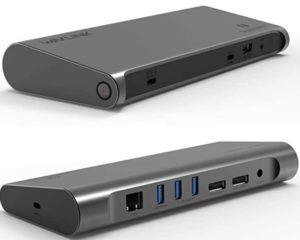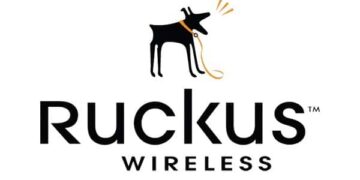About 18 months ago I requested a MacBook Pro at work, instead of refreshing my Windows Lenovo laptop. I’ve always been a Windows user, so I was a bit unsure about the switch at first. However, already being in the Apple ecosystem with an iPhone, Apple Watch, iPad and Apple TV, a MacBook Pro just seemed like the next logical step.
This post is not a review of MacOS, nor is it one of my step-by-step how-to guides. But, rather, this is a list of both hardware and software that I’ve found over the last 1.5 years that I use on a daily basis. If you are coming from Windows to MacOS, this will be a great guide for you. If you are already a MacOS user, you may find some new tidbits that are useful to you.
Hardware Accessories
First, I’m going to assume that your Mac has Thunderbolt 3 ports. Nearly all portable Macs made in the last 5 years have Thunderbolt 3 ports. My work MacBook is a 2018 13.3″ model with 4 ThunderBolt 3 ports, and my personal 2020 13.3″ MacBook also has 4 ports. The maximum resolution and refresh rate do vary from MacBook Pro model to model, so check the specs of your particular MacBook Pro for what it can support. My 13.3″ 2020 MBP can support one 6K monitor at 30 Hz, one 5K at 30Hz, or dual 4K at 60Hz, plus of course lower resolutions.
Monitors
In anticipation of having two MacBooks at my house (work and personal), I really wanted a dual 4K 27″ 60Hz monitor setup with a built-in KVM so that I didn’t need to buy an expensive dual head DisplayPort 1.4 KVM. After much research, I settled on the BenQ PD2720 27″ 4K monitor. This monitor has native Thunderbolt 3 support, 2x USB-C power delivery (65w/15w), DisplayPort 1.4 input, a few USB-A ports, and supports daisy chaining two monitors. While not cheap, these two monitors are simply amazing! And the built-in KVM functionality works without a hitch. If you want a single 32″ 4K monitor, or go for broke with dual 32″ 4K monitors, BenQ makes the PD3220U model.
Docking Station
The ThunderBolt 3 market is flooded with docks that range from cheap junk to expensive junk, with a few gems in between that actually deliver. If you have one MacBook, you may not need a docking station as the BenQ monitors may be sufficient for your needs, delivering power, displays, and a couple of USB-A ports via a single ThunderBolt 3 cable. But if you expand to two MacBook Pros, the second Mac will need a docking station so you can give it power, provide DisplayPort outputs, and give you a couple of USB-A ports.
The simply stunning Wavlink UTD3 is the dock I chose, which has been rock solid. It uses the latest Intel Titan Ridge ThunderBolt 3 chipset and supports one 8K at 30Hz, one 5K at 30Hz or dual 4K at 60Hz via two DisplayPort 1.4 ports. It also gives you 60w USB-C Power Delivery, gigabit ethernet, USB-A ports, and a USB-C port. Plus it’s in a nice looking wedge shape in space grey. It was available on Amazon, but as of this publication date is now unavailable. However, the more boxy Wavlink UTD21 has the exact same specs and ports, and is available for $179.99. Other docks I’ve tried, like those from CalDigit, were junk.
Keyboard and Mouse
A keyboard and mouse are very personal choices, and the market has a very wide variety to suit your personal needs. However, I wanted a clean desk so I wanted a wireless pair so I didn’t have cables all over the place. I also wanted USB-C recharging for both, and a USB dongle for connectivity and use with the BenQ built-in KVM I have. I settled on the Logitech MX Keys keyboard and the Logitech MX master 3 mouse. Both work exceptionally well, have long battery life, and switched flawlessly with the BenQ monitors.
Software
While I was pretty familiar with what hardware I wanted for my MacBook Pro computers, I had never used MacOS before so the last 18 months has been a fun exploration of what’s available for MacOS. The remainder of this blog post will be the MacOS software that I’ve found very useful.
1Password is an awesome cross-platform password manager that I use on all my devices, including Windows computers. I’ve been using it for years, so it’s natural that I’m using it on my Macs (and iPhone, iPad, etc.).
Aerial screen savers are simply amazing, and free!
Alfred 4 is a widely used productivity tool that I use daily. it does so much, you really have to check out their website. I use it for enhanced searching, and quick launching of programs that aren’t on my dock.
Amphetamine is a great tool for keeping your Mac awake when you never want it to snooze. Highly customizable.
ApplePiBaker is a tool aimed at people with Raspberry Pi devices to manage SD cards. If you have a Raspberry Pi, this free tool is a must!
BelenaEtcher is another Raspberry Pi tool which writes OS images to various removable media.
Bartender 3 is a tool for hiding some of your icons in the Mac toolbar. Personally I hide about 12 icons to keep my primary toolbar decluttered. Very customizable.
Better Battery 2 enhances the Mac toolbar battery status with a lot more detail about battery health, remaining run time, etc.
Carbon Copy Cloner is a backup tool that can create bootable backups of your entire Mac, among other features. I use this on my personal Mac to backup my whole Mac to a USB-C drive on a nightly basis. Support APFS, snapshots, and has a great scheduler.
CleanMyMac X is a great system optimization tool that finds junk on your Mac and helps clean it up. It also has an on-demand malware scanner (NOT real-time).
Connect Me Now is a major enhancement to MacOS for mounting network drives (CIFS, NFS, etc). I use this tool for intelligently mounting various drives from my Synology NAS.
Core Shell is a great premium SSH client. I prefer Royal TSX, but core shell is good too.
EjectBar is a nice tool for quickly and safely ejecting removable media from your Mac’s toolbar.
Fantastical is a simply amazing calendar tool with apps for MacOS, iOS, iPadOS and WatchOS. I could not function without this program. It’s that good and customizable!
HTTPS Now for Safari is a plug-in that tries to connect to sites using HTTPS vs HTTP. While I almost never use Safari, this provides a bit more security when I do use it.
IINA is a modern media player for MacOS. Replaced VLC for me.
iStat Menus is a visually beautiful menu bar monitoring tool that gives you a lot of system stats at a glance.
Keka is a great archiving and unarchiving utility. More “Mac” like than The Unarchiver.
Meeter is a FREE app that gives you one-click access to Zoom, WebEx, MS Teams, and a whole slew of other collaboration tool meetings. Totally cool and very customizable.
Moom is a great window manager for the Mac, as Apple has neglected this native feature for decades.
Microsoft Edge is a Chromium based browser that I use 99% of the time on my Mac and iPhone. I really like the support for multiple user profiles, the ability to use nearly any Chrome plugin, and the extra privacy features that are lacking in Chrome.
PiBar is a great toolbar utility those that run Pi-Holes at home or for your friends/family. It gives you stats and a quick way to disable multiple Pi-Holes right from your Mac toolbar. Very handy! iOS and WatchOS apps are likely coming in the future from the same developer.
Royal TSX is an amazing tool for administrators that let’s you SSH, FTP, SFTP, SCP, etc. Mind blowing beautiful UI, and even has TouchID integration for strong protection of your passwords and SSH keys.
Screens 4 is a premium VNC client. Great for remotely connecting to nearly any computer including Mac, Windows, Raspberry Pi, etc. Intercepts local hotkeys (yes!), unlike the native Apple screen sharing client.
SnagIt 2020 is a great screen capture and annotation tool. I use it extensively for my blog posts and when creating documentation.
Sophos Home Premium for Mac is a top-rated all around anti-malware program. Lightweight and cloud managed.
SoundSource 4 give you highly granular control over your Mac’s audio, including per-app volume and effect settings. Amazing!
SwitchResX is an awesome tool that provides highly customizable resolution and refresh rate control over your Mac displays. I have dual 4K monitors, but found that the crappy Apple controls didn’t provide enough control over the resolution and font size. This tool gives me the fine grained resolution control I need that allows 4K to be usable on 27″ monitors.
ToothFairy is a must-have app for quickly connecting and disconnecting Bluetooth devices, such as AirPods (or nearly any BT device). Assignable hotkeys for quick connect/disconnect.
Visual Studio Code (Free) by Microsoft, is a great IDE for writing code in nearly any language. Huge catalog of plug-ins available.
Viscosity is a premium OpenVPN client.
VLC is a general purpose media player for MacOS. Outdated interface, IMHO, so I use IIna instead.
WireGuard is the new VPN on the block, which I run on two Raspberry Pi servers. Super fast and very reliable. Faster than OpenVPN. Great for connecting back to your home network.
Summary
The initial adjustment from Windows to MacOS was somewhat of a shock, but after 18 months of using my Mac, I would not go back to Windows 10. While MacOS is far from perfect, the above software and hardware really make MacOS a very pleasant, and fruity, computing experience.







Curious what you hated about the CalDigit…I love mine.
I had endless issues with my dual 4K monitors. Black screens, etc.